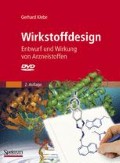Auszug
Die Wechselwirkung einer Substanz mit der Bindestelle eines therapeutisch relevanten biologischen Makromoleküls ist die entscheidende Grundlage für ihre Eignung als Arzneistoff. Eine andere, nicht minder wichtige Voraussetzung ist die Fähigkeit der Substanz, vom Ort der Applikation auf einem oft sehr verschlungenen Weg zum Wirkort zu gelangen. Dazu muss die Substanz wässrige Phasen und Lipidmembranen durchdringen. Je nach ihrer Wasser- und Lipidlöslichkeit wird sie auf diesem Weg in unterschiedliche Bereiche (Kompartimente) des biologischen Systems gelangen. Durch metabolisierende Enzyme wird sie chemisch verändert. Nach Konjugation oder Abbau wird sie schließlich über die Niere, die Galle und/oder den Darm ausgeschieden (Abschnitt 9.1).
Access this chapter
Tax calculation will be finalised at checkout
Purchases are for personal use only
Preview
Unable to display preview. Download preview PDF.
Literatur
Allgemeine Literatur
H. Kubinyi, Lipophilicity and Drug Activity, Progr. Drug Res. 23, 97–198 (1979)
J. K. Seydel und K.-J. Schaper, Quantitative Structure-Pharmacokinetic Relationships and Drug Design, Pharmac. Ther. 15, 131–182 (1982)
J. M. Mayer und H. van de Waterbeemd, Development of Quantitative Structure-Pharmacokinetic Relationships, Environ. Health Perspect. 61, 295–306 (1985)
J. C. Dearden, Molecular Structure and Drug Transport, in: Quantitative Drug Design, C. A. Ramsden, Hrsg., Band 4 von: Comprehensive Medicinal Chemistry, C. Hansch, P. G. Sammes und J. B. Taylor, Hrsg., Pergamon Press, Oxford, 1990, S. 375–411
H. Kubinyi, QSAR: Hansch Analysis and Related Approaches, VCH, Weinheim, 1993
H. Kubinyi, Der Schlüssel zum Schloss. II. Hansch-Analyse, 3DQSAR und De novo-Design, Pharmazie in unserer Zeit 23, 281–290 (1994)
C. Hansch and A. Leo, Exploring QSAR. Fundamentals and Applications in Chemistry and Biology, Band 1, American Chemical Society, Washington, 1995
E. Kutter, Arzneistoffentwicklung. Grundlagen — Strategien — Perspektiven, Georg Thieme Verlag, Stuttgart, 1978
R. L. Lipnick, Selectivity, in: General Principles, P. D. Kennewell, Hrsg., Band 1 von: Comprehensive Medicinal Chemistry, C. Hansch, P. G. Sammes und J. B. Taylor, Hrsg., Pergamon Press, Oxford, 1990, S. 239–247
H. Kubinyi, QSAR: Hansch Analysis and Related Approaches, VCH Weinheim, 1993
H. Kubinyi, Lock and Key in the Real World: Concluding Remarks, Pharmac. Acta Helv. 69, 259–269 (1995)
C. A. Reinhardt, Hrsg., Alternatives to Animal Testing, VCH, Weinheim, 1994
R. Mannhold, Ed. Molecular Drug Properties, Wiley-VCH, Weinheim, 2008
D. A. Smith, H. van der Waterbeemd und D. K. Walker, Pharmacokinetics and Metabolism in Drug Design, Wiley-VCH, Weinheim, 2006
B. Testa und H. van der Waterbeemd, (Eds)., ADME-Tox Approaches, Vol. 5 of Comprehensive Medicinal Chemistry II, Elsevier, 2007
Spezielle Literatur
B. C. Lippold und G. F. Schneider, Zur Optimierung der Verfügbarkeit homologer quartärer Ammoniumverbindungen, 2. Mitteilung: In-vitro-Versuche zur Verteilung von Benzilsäureestern homologer Dimethyl-(2-hydroxyäthyl)-alkylammoniumbromide, Arzneim.-Forsch. 25, 843–852 (1974)
H. Kubinyi, Drug Partitioning: Relationships between Forward and Reverse Rate Constants and Partition Coefficient, J. Pharm. Sci. 67, 262–263 (1978)
H. van de Waterbeemd, P. van Bakel und A. Jansen, Transport in Quantitative Structure-Activity Relationships VI: Relationship between Transport Rate Constants and Partition Coefficients, J. Pharm. Sci. 70, 1081–1082 (1981)
C. Hansch, J. P. Björkroth und A. Leo, Hydrophobicity and Central Nervous System Agents: On the Principle of Minimal Hydrophobicity in Drug Design, J. Pharm. Sci. 76, 663–687 (1987)
H. van de Waterbeemd und M. Kansy, Hydrogen-Bonding Capacity and Brain Penetration, Chimia 46, 299–303 (1992)
A. Tsuji, E. Miyamoto, N. Hashimoto und T. Yamana, GI Absorption of γ-Lactam Antibiotics II: Deviation from pH-Partition Hypothesis in Penicillin Absorption through In Situ and In Vitro Lipoidal Barriers, J. Pharm. Sci. 67, 1705–1711 (1978)
P. Seeman und H. H. M. Van Tol, Dopamine Receptor Pharmacology, Trends Pharm. Sci. 15, 264–270 (1994)
B. D. Gitter et al., Species Differences in Affinitites of Non-Peptide Antagonists for Substance P Receptors, Eur. J. Pharmacol. 197, 237–238 (1991)
J.-P. Clozel und W. Fischli, Discovery of Remikiren as the First Orally Active Renin Inhibitor, Arzneim.-Forsch. 43, 260–262 (1993)
V. Dhanaraj et al., X-Ray Analyses of Peptide-Inhibitor Complexes Define the Structural Basis of Specificity for Human and Mouse Renins, Nature 357, 466–472 (1992)
E. M. Parker, D. A. Grisel, L. G. Iben und R. S. Shapiro, A Single Amino Acid Difference Accounts for the Pharmacological Distinctions Between the Rat and Human 5-Hydroxytryptamine-1B Receptors, J. Neurochem. 60, 380–383 (1993)
D. J. Hanson, Dioxin Toxicity: New Studies Prompt Debate, Regulatory Action, Chem. Eng. News (August 12, 1991), 7–14
M. J. Matfield, Animal Liberation or Animal Research? Trends Pharm. Sci. 12, 411–415 (1991)
Rights and permissions
Copyright information
© 2009 Spektrum Akademischer Verlag Heidelberg
About this chapter
Cite this chapter
(2009). Von in vitro zu in vivo: Optimierung von ADME-Tox-Eigenschaften. In: Wirkstoffdesign. Spektrum Akademischer Verlag. https://doi.org/10.1007/978-3-8274-2213-2_20
Download citation
DOI: https://doi.org/10.1007/978-3-8274-2213-2_20
Publisher Name: Spektrum Akademischer Verlag
Print ISBN: 978-3-8274-2046-6
Online ISBN: 978-3-8274-2213-2
eBook Packages: Medicine (German Language)

